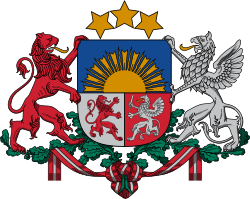| Coat of arms of Latvia | |
|---|---|
 Greater version | |
| Versions | |
 Middle version | |
 Lesser version | |
| Armiger | Republic of Latvia |
| Adopted | June 15, 1921 |
| Crest | An arc of three mullets Or |
| Shield | Per fess and in base per pale: 1st Azure, a demi-sun issuing from base Or; 2nd Argent, a lion rampant contourné Gules; 3rd Gules, a gryphon segreant brandishing in the dexter claw a sword Argent. |
| Supporters | Dexter, a lion rampant Gules, and sinister, a griffin segreant Argent; both langued Or |
| Compartment | Two oak branches fructed Vert tied together by a ribbon Sanguine charged with a bar Argent |
The Coat of arms of the Republic of Latvia was officially adopted by the Constitutional Assembly of Latvia on 15 June 1921, and entered official use starting on 19 August 1921. It was created using new national symbols, as well as elements of the coats of arms of Polish and Swedish Livonia and of the Duchy of Courland and Semigallia. Thus, the coat of arms combines symbols of Latvian national statehood, as well as symbols of its historical regions.[1] The Latvian national coat of arms was designed by Latvian artists Vilhelms Krūmiņš and Rihards Zariņš.[2][3][4]
Previously, after the proclamation of the independence of Latvia, an emblem was adopted by the People's Council of Latvia on 6 December 1918 as a 'national coat of arms'. The symbol, designed by Burkards Dzenis, consisted of a Sun (a symbol of self-determination, used in badges of the Latvian Riflemen) with 17 rays, symbolizing the counties inhabited by Latvians. The bottom of the disk was covered by a ribbon in the colors of the Latvian flag. At the center of the solar disk a letter "L" and three stars were placed. This emblem was mostly used in slightly different monochrome variations as an official seal (by the People's Council, the Constitutional Assembly and other government and military institutions, on the banknotes of the Latvian ruble, diplomatic passports etc.).[5]
- ^ Latvijas Republikas ģerbonis
- ^ "Rihards Zariņš" (in Latvian). Nacionālā enciklopēdija. Retrieved 28 August 2022.
- ^ de Vries, Hubert. "LATVIJA". De Rode Leeuw. Retrieved 31 August 2023.
- ^ Ducmane, Kristīne. "Simboli: Latvijas ģerbonis, karogs" (in Latvian). makslaplus.lv. Archived from the original on 24 February 2014. Retrieved 31 August 2023.
- ^ Lukša, Aloizs (1998-10-22). "Latvijas ģerboņu līnijas 1918 - 1940 - Latvijas Vēstnesis" [Outlines of the coats of arms of Latvia 1918-1940]. Latvijas Vēstnesis (in Latvian). Retrieved 2023-12-17.